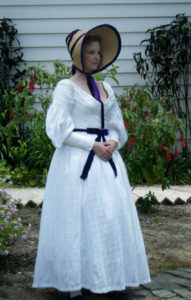-1830s cotton day dress



Status: Wearable
Year finished: 2011
To Do: resize, sew eyelets
Updates since last photo: n/a
Inspiration: extant gowns at KCI etc. of the period between the balloon sleeves of the 1820s and fitted sleeves of the 1840s
I have a particular fascination for “transitional styles” where one extreme of fashion somehow turns into another extreme.
This dress is was dreamed of for a long time, I had some cotton self check curtains that were crying out to be an early 19thC dress of some sort. I wasn’t sure I’d have enough for both the bias cut pleated bertha and bias cut pleated sleeves as well as a skirt, but with careful proper period piecing I was able to have all the elements I wanted with virtually no scraps left over!



The sleeves are cut as if they were large Gigot sleeves but with the upper half pleated and tacked in to place. this involved matching left and right sleeves as well as left and right of each sleeve- the window pane check pattern is not a perfect square so this took some time.



The bertha was first pressed in to pleats for each side and then stitched in place by machine (as large tucks) and finally sewn by hand over the bodice.
The bodice was made first in two layers of canvas and the fashion fabric applied on the bias only where it would be seen so as to save on fabric. The back has squared off “princess” side back seams, the front a single dart under each bust as per period practice.
The bodice was hand finished at the waist though a separate lining was not put in place.
The skirt is made from three gored panels (front and side fronts) and the back is from one straight width of fabric (a modification of my Historic Skirt Guides to suit a Romantic era bell shape.) This is a great conservator of fabric and while it would be both forward and backward looking for this particular period it is an authentic practice. Though as mentioned the fashion right on this date would have been for a completely straight cut skirt as can be seen in Patterns of Fashion and History of Costume (first ed. Blanch Payne).